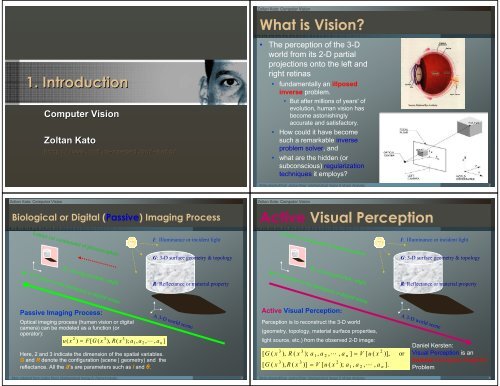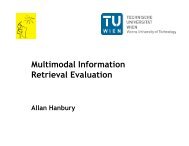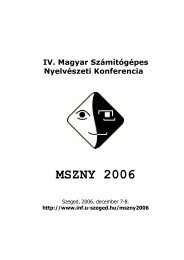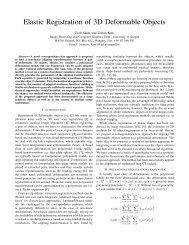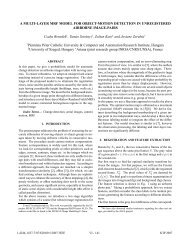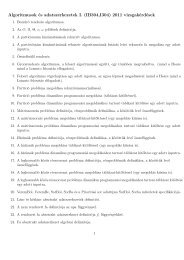1. Introduction What is Vision? Active Visual Perception
1. Introduction What is Vision? Active Visual Perception
1. Introduction What is Vision? Active Visual Perception
You also want an ePaper? Increase the reach of your titles
YUMPU automatically turns print PDFs into web optimized ePapers that Google loves.
<strong>1.</strong> <strong>Introduction</strong><br />
Zoltan Kato: Computer V<strong>is</strong>ion<br />
Computer V<strong>is</strong>ion<br />
Zoltan Kato<br />
http://www.inf.u<br />
http://www.inf.u-szeged.hu/~kato<br />
http://www.inf.u szeged.hu/~kato<br />
szeged.hu/~kato/<br />
Biological or Digital (Passive) Imaging Process<br />
Lattice (or continuum) of photoreceptors<br />
θ: viewing position | angle<br />
u: 2-D image on the biological or digital retina<br />
Passive Imaging Process:<br />
Optical imaging process (human v<strong>is</strong>ion or digital<br />
camera) can be modeled as a function (or<br />
operator):<br />
2<br />
3 3<br />
u( x ) = F [ G ( x ), R(<br />
x ); a1,<br />
a 2 , L , a<br />
Here, 2 and 3 indicate the dimension of the spatial variables.<br />
G and R denote the configuration (scene | geometry) and the<br />
reflectance. All the a’s are parameters such as I and θ.<br />
I: Illuminance or incident light<br />
G: 3-D surface geometry & topology<br />
R: Reflectance or material property<br />
A 3-D world scene<br />
Slide adopted from Jackie Shen: Mathematical Image & V<strong>is</strong>ion Analys<strong>is</strong>. Analys<strong>is</strong>.<br />
3<br />
n<br />
]<br />
Zoltan Kato: Computer V<strong>is</strong>ion<br />
<strong>What</strong> <strong>is</strong> V<strong>is</strong>ion?<br />
• The perception of the 3-D<br />
world from its 2-D partial<br />
projections onto the left and<br />
right retinas<br />
• fundamentally an illposed<br />
inverse problem.<br />
• But after millions of years' of<br />
evolution, human v<strong>is</strong>ion has<br />
become aston<strong>is</strong>hingly<br />
accurate and sat<strong>is</strong>factory.<br />
• How could it have become<br />
such a remarkable inverse<br />
problem solver, and<br />
• what are the hidden (or<br />
subconscious) regularization<br />
techniques it employs?<br />
Slide adopted from Jackie Shen: Mathematical Image & V<strong>is</strong>ion Analys<strong>is</strong>. Analys<strong>is</strong>.<br />
2<br />
Zoltan Kato: Computer V<strong>is</strong>ion<br />
<strong>Active</strong> V<strong>is</strong>ual <strong>Perception</strong><br />
Lattice (or continuum) of photoreceptors<br />
θ: viewing position | angle<br />
u: 2-D image on the biological or digital retina<br />
<strong>Active</strong> V<strong>is</strong>ual <strong>Perception</strong>:<br />
<strong>Perception</strong> <strong>is</strong> to reconstruct the 3-D world<br />
(geometry, topology, material surface properties,<br />
light source, etc.) from the observed 2-D image:<br />
3<br />
3<br />
[ G ( x ), R ( x ); a 1 , a 2 , L , a n ] = V [ u ( x )],<br />
3 3<br />
2<br />
[ G ( x ), R ( x )] = V [ u ( x ); a , a , L , a ].<br />
1<br />
2<br />
I: Illuminance or incident light<br />
G: 3-D surface geometry & topology<br />
R: Reflectance or material property<br />
A 3-D world scene<br />
Slide adopted from Jackie Shen: Mathematical Image & V<strong>is</strong>ion Analys<strong>is</strong>. Analys<strong>is</strong>.<br />
4<br />
2<br />
n<br />
or<br />
Daniel Kersten:<br />
V<strong>is</strong>ual <strong>Perception</strong> <strong>is</strong> an<br />
Inverse Computer Graphics<br />
Problem
Zoltan Kato: Computer V<strong>is</strong>ion<br />
V<strong>is</strong>ion <strong>is</strong> an Illposed Inverse Problem<br />
A. Geometry <strong>is</strong> not invertible: depth or range <strong>is</strong> lost !<br />
Mathematical Model (1): Projective Imaging<br />
P: (x1, x2, x3) � (x1, x2) <strong>is</strong> not invertible!<br />
For any given 2-D curve γ2, there are infinitely many<br />
3-D curves γ3, so that P(γ3) = γ2 .<br />
Example. γ3 = (cos t, sin t, t )<br />
γ2 <strong>is</strong> just like the projection of a circle<br />
Slide adopted from Jackie Shen: Mathematical Image & V<strong>is</strong>ion Analys<strong>is</strong>. Analys<strong>is</strong>.<br />
5<br />
Zoltan Kato: Computer V<strong>is</strong>ion<br />
Human V<strong>is</strong>ion<br />
The human v<strong>is</strong>ion system <strong>is</strong> a well developed<br />
system of software and hardware, which can solve<br />
th<strong>is</strong> highly ill-posed inverse problem efficiently and<br />
robustly.<br />
Fundamental Questions:<br />
• <strong>What</strong> kind of regularization techniques the human<br />
v<strong>is</strong>ion system employs to conquer the illposedness?<br />
• <strong>What</strong> kind of features or variables to regularize ?<br />
Slide adopted from Jackie Shen: Mathematical Image & V<strong>is</strong>ion Analys<strong>is</strong>. Analys<strong>is</strong>.<br />
7<br />
Zoltan Kato: Computer V<strong>is</strong>ion<br />
V<strong>is</strong>ion <strong>is</strong> an Illposed Inverse Problem<br />
B. The Reflectance-Illuminance entanglement.<br />
different 3-D scenes<br />
R<br />
I<br />
I<br />
R<br />
identical images !<br />
Slide adopted from Jackie Shen: Mathematical Image & V<strong>is</strong>ion Analys<strong>is</strong>. Analys<strong>is</strong>.<br />
6<br />
Zoltan Kato: Computer V<strong>is</strong>ion<br />
<strong>Perception</strong> as Bayesian Inference<br />
Bayesian <strong>Perception</strong> (D. Kersten, A. Yuille, D. Mumford,…):<br />
X = (geometry G, reflectance R, …).<br />
max<br />
X<br />
Prob<br />
( X<br />
| U<br />
0<br />
)<br />
=<br />
Prob<br />
( U 0 | X ) Prob<br />
Prob ( U )<br />
Slide adopted from Jackie Shen: Mathematical Image & V<strong>is</strong>ion Analys<strong>is</strong>. Analys<strong>is</strong>.<br />
8<br />
0<br />
( X<br />
It <strong>is</strong> our a priori knowledge of the world (i.e.,<br />
Prob(X ) ) that regularizes our v<strong>is</strong>ual perception!<br />
)
Zoltan Kato: Computer V<strong>is</strong>ion<br />
A Priori Knowledge (Common Sense) of the World Regularizes V<strong>is</strong>ion<br />
• G: Knowledge of curve and shape geometry;<br />
• I: Knowledge of light sources & illuminance (sun,<br />
lamps, indoor or outdoor, …);<br />
• R: Knowledge of materials (wood, bricks, …) and<br />
surface reflectance (metal shines and water<br />
sparkles, …)<br />
• Θ : Knowledge of the viewers (often standing<br />
perpendicularly to the ground, viewing more<br />
horizontally, several feet away for indoor scenes, …)<br />
• ……<br />
Slide adopted from Jackie Shen: Mathematical Image & V<strong>is</strong>ion Analys<strong>is</strong>. Analys<strong>is</strong>.<br />
9<br />
Zoltan Kato: Computer V<strong>is</strong>ion<br />
<strong>Perception</strong> and Illusion<br />
• Size, length, angles<br />
• Order & depth<br />
• Shade perception<br />
• Grouping<br />
• Interpolation & Continuation<br />
• Light & Surface<br />
• Texture gradient<br />
• Linear perspective<br />
11<br />
Zoltan Kato: Computer V<strong>is</strong>ion<br />
<strong>What</strong> to Learn & How<br />
• How does the v<strong>is</strong>ion system subconsciously<br />
choose what knowledge to learn and store,<br />
out of massive v<strong>is</strong>ual data in daily life?<br />
• For such knowledge, to which degree of<br />
regularity or compression that the v<strong>is</strong>ion<br />
system “decides” to process, in order to<br />
achieve maximum efficiency and robustness?<br />
• How to mathematically model (or quantify)<br />
such activities?<br />
Slide adopted from Jackie Shen: Mathematical Image & V<strong>is</strong>ion Analys<strong>is</strong>. Analys<strong>is</strong>.<br />
10<br />
Zoltan Kato: Computer V<strong>is</strong>ion<br />
Illusions: Size, Length, Angles<br />
W a<br />
Human v<strong>is</strong>ual perception: the length W a <strong>is</strong> longer than W b .<br />
Fact: the two shaded surfaces are identical up to a rotation !<br />
Question: How to model humans’ perception of geometry?<br />
Slide adopted from Jackie Shen: Mathematical Image & V<strong>is</strong>ion Analys<strong>is</strong>. Analys<strong>is</strong>.<br />
12<br />
W b
Zoltan Kato: Computer V<strong>is</strong>ion<br />
Illusion: Order & Depth<br />
Human v<strong>is</strong>ual perception: the poor man <strong>is</strong> entangled in the fence.<br />
Fact: common sense tells us that he <strong>is</strong> behind the fence.<br />
G. Kanizsa [1978]<br />
Nitzberg-Mumford-Shiota [1993]<br />
Chan-Shen [SIAP, 2001]<br />
Question: How to model human’s perception of depth? The lost 3 rd D.<br />
Slide adopted from Jackie Shen: Mathematical Image & V<strong>is</strong>ion Analys<strong>is</strong>. Analys<strong>is</strong>.<br />
13<br />
Zoltan Kato: Computer V<strong>is</strong>ion<br />
V<strong>is</strong>ual Organization: Grouping<br />
u<br />
d<br />
D. Kersten [V<strong>is</strong>ion Psychology & Computation, UMN]<br />
For image u, we “see” two human faces. No doubt.<br />
If we move the face contours closer till touch (image v), do we still<br />
percept two human faces? Or two simians? Psycholog<strong>is</strong>ts show that<br />
most of us percept the latter. (Gestalt V<strong>is</strong>ion Science).<br />
Question: How to model humans’ perception of topology and grouping?<br />
Slide adopted from Jackie Shen: Mathematical Image & V<strong>is</strong>ion Analys<strong>is</strong>. Analys<strong>is</strong>.<br />
15<br />
v<br />
d=0<br />
Zoltan Kato: Computer V<strong>is</strong>ion<br />
Illusion: Shade <strong>Perception</strong><br />
Ed. Adelson [MIT Cognitive & Comp. Neuron Sciences, 2000]<br />
Human v<strong>is</strong>ual perception: the left heart <strong>is</strong> brighter than the right.<br />
Fact: they are identical, with the same shape, size, and shade!<br />
Question: How to model humans’ perception of light and shades?<br />
(i.e., how do our neurons encode and compute photon inputs?)<br />
Slide adopted from Jackie Shen: Mathematical Image & V<strong>is</strong>ion Analys<strong>is</strong>. Analys<strong>is</strong>.<br />
14<br />
Zoltan Kato: Computer V<strong>is</strong>ion<br />
V<strong>is</strong>ual Interpolation & Continuation<br />
G. Kanizsa [1978]<br />
Nitzberg-Mumford-<br />
Shiota [1993]<br />
Chan-Shen [SIAP, 2001]<br />
Chan-Kang-Shen [V<strong>is</strong>ual<br />
Comm., 2001]<br />
Interpolation <strong>is</strong> universal in daily life due to object occlusions in 3-D.<br />
Clinical evidences show that it <strong>is</strong> not born with us. Many patients with<br />
v<strong>is</strong>ion defects have difficulty in connecting all the broken and separated<br />
parts. To them, the world <strong>is</strong> piece by piece.<br />
Question: How to model the interpolation algorithms of v<strong>is</strong>ion neurons?<br />
Slide adopted from Jackie Shen: Mathematical Image & V<strong>is</strong>ion Analys<strong>is</strong>. Analys<strong>is</strong>.<br />
16
Zoltan Kato: Computer V<strong>is</strong>ion<br />
Depth Cues: Light & Surface<br />
Illumination gradients: gradients and shadow lend a sense of depth<br />
Slide adopted from Jackie Shen: Mathematical Image & V<strong>is</strong>ion Analys<strong>is</strong>. Analys<strong>is</strong>.<br />
17<br />
Zoltan Kato: Computer V<strong>is</strong>ion<br />
Depth Cues: Linear Perspective<br />
Wat Phra Kaew, Kaew,<br />
Bangkok, Thailand – http://www.cameradigita.com<br />
http:// www.cameradigita.com/<br />
Lines will appear to draw closer together as they go farther into the d<strong>is</strong>tance.<br />
19<br />
Zoltan Kato: Computer V<strong>is</strong>ion<br />
Depth Cues: Texture Gradient<br />
Linear Perspective: objects appear smaller as they recede into the<br />
d<strong>is</strong>tance<br />
Zoltan Kato: Computer V<strong>is</strong>ion<br />
Depth Cues: Motion Parallax<br />
• differential<br />
perception of motion<br />
(speed and direction)<br />
as a function of<br />
d<strong>is</strong>tance from<br />
perceiver<br />
• Objects moving<br />
faster are appearing<br />
closer<br />
http://epsych.msstate.edu/descriptive/V<strong>is</strong>ion/mparallax/DC<strong>1.</strong>html<br />
18<br />
20
Zoltan Kato: Computer V<strong>is</strong>ion<br />
Depth Cues: Binocular D<strong>is</strong>parity<br />
• Each eye receives a slightly different image of the<br />
world from which 3D positions can be inferred.<br />
• D<strong>is</strong>parity - The difference in retinal position<br />
between the corresponding points in two images.<br />
D<strong>is</strong>parity <strong>is</strong> inversely proportional to the depth of the<br />
point in space.<br />
Zoltan Kato: Computer V<strong>is</strong>ion<br />
Theory of V<strong>is</strong>ual <strong>Perception</strong><br />
• The information we receive<br />
by our eyes <strong>is</strong> relatively<br />
impover<strong>is</strong>hed.<br />
• For example, the retina<br />
receives a grainy 2D image of<br />
the v<strong>is</strong>ual scene…<br />
• …that includes large gaps<br />
(blind spots)…<br />
• …and an uneven<br />
representation of colour<br />
(cones) and luminance (rods).<br />
• Th<strong>is</strong> information <strong>is</strong><br />
transformed into a rich<br />
v<strong>is</strong>ual experience.<br />
21<br />
23<br />
Zoltan Kato: Computer V<strong>is</strong>ion<br />
Perceptual Constancy<br />
Size constancy<br />
• We tend to experience objects as the same, despite the<br />
image they produce on the retina may vary greatly.<br />
• Shape constancy – objects seen from different angles do not appear<br />
different or to change shape<br />
• Size constancy – objects do not seem to change size when they move<br />
nearer or further away.<br />
• Color constancy – differing illumination does not affect color despite<br />
changes in the actual reflected light.<br />
Zoltan Kato: Computer V<strong>is</strong>ion<br />
Theory of V<strong>is</strong>ual <strong>Perception</strong>: Marr<br />
• Theories of v<strong>is</strong>ual perception attempt to explain how<br />
th<strong>is</strong> happens.<br />
• David Marr: V<strong>is</strong>ion: A Computational Investigation<br />
into the Human Representation and Processing of<br />
V<strong>is</strong>ual Information, 1982.<br />
• wanted to understand mechan<strong>is</strong>ms of v<strong>is</strong>ion rather<br />
than just behaviours associated with it.<br />
• He took an information processing view of the mind…<br />
• …and aimed to describe perception in terms of<br />
computations on sense data…<br />
• …to extract high level v<strong>is</strong>ual experience.<br />
22<br />
24
Zoltan Kato: Computer V<strong>is</strong>ion<br />
Marr: Computational Approach<br />
• Marr proposed there were d<strong>is</strong>tinct stages of<br />
processing in v<strong>is</strong>ual perception (Bottom-Up):<br />
• Raw Primal Sketch<br />
• Complete Primal Sketch<br />
• 2½D Sketch<br />
• Full 3D Representation<br />
Zoltan Kato: Computer V<strong>is</strong>ion<br />
Gestalt laws of Perceptual Grouping<br />
25<br />
27<br />
Zoltan Kato: Computer V<strong>is</strong>ion<br />
Marr: Primal Sketch<br />
• Early primal sketch involves the extraction of information<br />
regarding edges and intensity changes.<br />
• Then a Complete Primal Sketch <strong>is</strong> created by grouping<br />
surfaces and common areas<br />
• The Gestalt Psycholog<strong>is</strong>ts of the early 19th Century demonstrated<br />
many different ways in which we can group objects.<br />
Zoltan Kato: Computer V<strong>is</strong>ion<br />
Marr: 2½D Sketch<br />
• After gaining information about groupings and<br />
surfaces the viewer needs some spatial<br />
information.<br />
• Marr called th<strong>is</strong> stage the 2½D Sketch to<br />
emphas<strong>is</strong> that th<strong>is</strong> stage didn’t give a full 3D<br />
representation.<br />
• Just an estimate of the spatial locations of<br />
objects and materials in relation to the viewer.<br />
• Depth cues<br />
26<br />
28
Zoltan Kato: Computer V<strong>is</strong>ion<br />
Marr: 3D Model Representation<br />
• A full 3D description of our spatial<br />
environment involving the<br />
• identification of the structure of objects and<br />
• materials in our v<strong>is</strong>ual scene.<br />
• It allows us to work out the 3D environment<br />
from a non-egocentric point-of-view.<br />
Zoltan Kato: Computer V<strong>is</strong>ion<br />
Shape from Shading<br />
[ Emmanuel Prados and Olivier Faugeras, Faugeras,<br />
ECCV 2004 ]<br />
http://www-sop.inria.fr/odyssee/research/prados<br />
http://www sop.inria.fr/odyssee/research/prados-faugeras:04b/demo_real_images/demo_real_images.html<br />
faugeras:04b/demo_real_images/demo_real_images.html<br />
29<br />
31<br />
Zoltan Kato: Computer V<strong>is</strong>ion<br />
Can Computers see as Humans?<br />
• Shape from shading<br />
• Shape from texture<br />
• Single view reconstruction<br />
• 2-view reconstruction (stereo v<strong>is</strong>ion)<br />
• Multi-view reconstruction<br />
• Tracking moving objects<br />
• Video mosaics<br />
• Video editing/inpainting<br />
• View synthes<strong>is</strong><br />
Zoltan Kato: Computer V<strong>is</strong>ion<br />
Shape from Texture<br />
http://www.csse.uwa.edu.au/~angie<br />
http:// www.csse.uwa.edu.au/~angie/<br />
30<br />
32
Zoltan Kato: Computer V<strong>is</strong>ion<br />
Single View Reconstruction<br />
Reconstructing a 3D scene from recognizable geometric primitives such as lines,<br />
planes and spheres by computing their spatial layout given only one view.<br />
Fellows Quad in Merton College, Oxford<br />
3D reconstruction of a photograph<br />
La Flagellazione di Cr<strong>is</strong>to (1460) by Piero della Francesca (1416-1492)<br />
Galleria Nazionale delle Marche<br />
3D reconstruction of a painting<br />
D.Liebowitz, D.Liebowitz,<br />
A. Crimin<strong>is</strong>i, Crimin<strong>is</strong>i,<br />
and A. Z<strong>is</strong>serman, Z<strong>is</strong>serman,<br />
V<strong>is</strong>ual Geometry Group, Oxford University, UK, 1998 - http://www.robots.ox.ac.uk/~vgg/projects/SingleView<br />
http:// www.robots.ox.ac.uk/~vgg/projects/SingleView/<br />
33<br />
Zoltan Kato: Computer V<strong>is</strong>ion<br />
Multi-view Stereov<strong>is</strong>ion<br />
[ J.-P. J. P. Pons, Pons,<br />
R. Keriven and O. Faugeras CVPR 2005]<br />
http://www-sop.inria.fr/odyssee/research/pons<br />
http://www sop.inria.fr/odyssee/research/pons-keriven keriven-etal:04b/demo<br />
etal:04b/demo/<br />
35<br />
Zoltan Kato: Computer V<strong>is</strong>ion<br />
Mobile Robot Navigation<br />
http://www.robots.ox.ac.uk/<strong>Active</strong>V<strong>is</strong>ion/Projects/Nav/nav.01/<br />
Zoltan Kato: Computer V<strong>is</strong>ion<br />
Tracking<br />
An Integrated Traffic and Pedestrian V<strong>is</strong>ion System, Leeds – Reeding, Reeding,<br />
UK, 1997<br />
http://www.scs.leeds.ac.uk/imv/index.html<br />
http:// www.scs.leeds.ac.uk/imv/index.html<br />
The Likelihood of a particular trajectory<br />
Dots above the heads indicate likelihood of a<br />
particular trajectory.<br />
Tracking results:<br />
Fitting models to cars<br />
and people<br />
34<br />
36
Zoltan Kato: Computer V<strong>is</strong>ion<br />
Video Mosaic/Panorama<br />
Zoltan Kato: Computer V<strong>is</strong>ion<br />
Video Inpainting<br />
Guillermo Sapiro, Sapiro,<br />
Kedar A. Patwardhan [ICIP 2005]<br />
http://www.tc.umn.edu/~patw0007/icip2005//<br />
http://www.tc.umn.edu/~patw0007/icip2005/<br />
Dynamosaics: Video Mosaics with Non-Chronological Time<br />
[CVPR 2005]<br />
http://www.v<strong>is</strong>ion.huji.ac.il/dynmos/<br />
Alex Rav-Acha, Yael Pritch, Dani L<strong>is</strong>chinski, Shmuel Peleg<br />
Hebrew University of Jerusalem, Israel<br />
With the limited field of view of human v<strong>is</strong>ion, our perception of most<br />
scenes <strong>is</strong> built over time while our eyes are scanning the scene. In the<br />
case of static scenes th<strong>is</strong> process can be modeled by panoramic<br />
mosaicing: stitching together images into a panoramic view. Can a<br />
dynamic scene, scanned by a video camera, be represented with a<br />
dynamic panoramic video even though different regions were v<strong>is</strong>ible at<br />
different times?<br />
Remove unwanted objects<br />
Yunjun Zhang, Jiangjian Xiao, Mubarak Shah –[UCF [UCF 2005]<br />
http://www.cs.ucf.edu/%7Ev<strong>is</strong>ion/projects/ImageVideoCompletion/<br />
37<br />
39<br />
Zoltan Kato: Computer V<strong>is</strong>ion<br />
Video Editing<br />
http://profs.sci.univr.it/~fusiello/demo/mosaics<br />
http:// profs.sci.univr.it/~fusiello/demo/mosaics/<br />
Zoltan Kato: Computer V<strong>is</strong>ion<br />
Insert new objects into a video sequence<br />
View Synthes<strong>is</strong>: EyeV<strong>is</strong>ion of CMU<br />
Takeo kanade [Carnegie Mellon University, USA, 2001]<br />
http://www.ri.cmu.edu/events/sb35/tksuperbowl.html<br />
The action was captured by more than 30 cameras, each with computer-controlled<br />
zoom and focus capabilities mounted on a custom-built, robotic pan-tilt head.<br />
These camera heads were controlled in concert so that cameras pointed, zoomed<br />
and focused at the same time on the same spot on the field, where a touchdown or<br />
fumble occurred.<br />
The detailed geometrical information about a scene <strong>is</strong> extracted by computer,<br />
which enables a person to choose how to view a scene, even from a perspective<br />
that was not shot by any camera.<br />
38<br />
40


